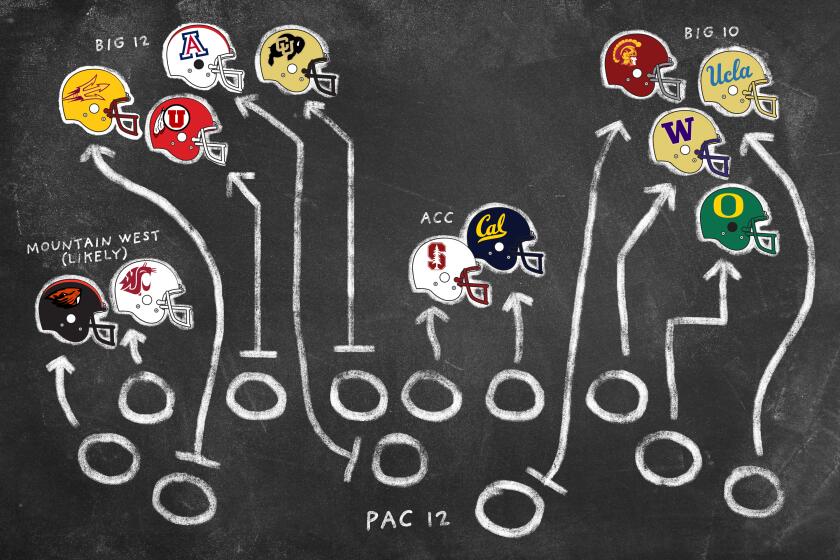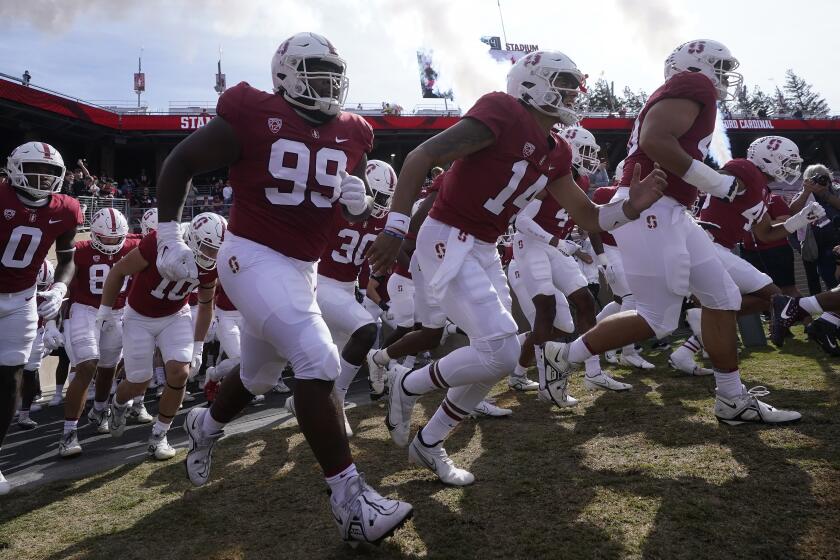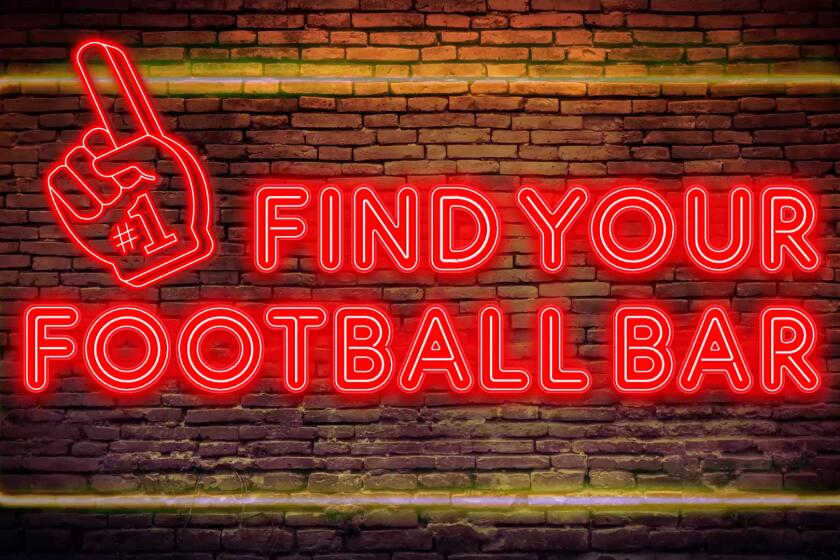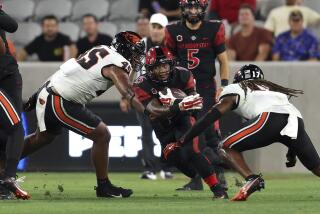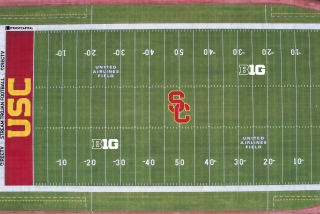Commentary: Amid the Pac-12 ruins, one big question emerges — why does the NCAA still exist?

- Share via
As we ponder the end of the Pac-12 Conference, should we celebrate the new Pac-2, or commiserate that so much of college sports has dropped into a giant cesspool? So many questions.
Should we feel bad for the wallflowers, Oregon State and Washington State, who now become the tragic twosome? Nobody wants to dance with them. OK, maybe the Mountain West will flirt, but from the Pac-12 to the Mountain West? C’mon.
Can the jilted pair look past their rejection, claim their sovereignty, and simply demand all the Pac-12 assets left behind? Or can they play each other every weekend, home and away — or maybe at the Rose Bowl, Coliseum, or Husky Stadium overlooking Lake Washington? Fans in those places might be starved for some real football after doses of Rutgers and Nebraska.
The cause of death was massive hemorrhaging, with 10 schools announcing plans to depart the conference in 2024.
Think about it. Oregon State is pretty good, and if it stayed that way next season, when the Big Ten has gobbled up its usual opponents, and beats Washington State 11 times, the Beavers would have to be in the College Football Assn.’s playoffs with all the big guys. What a story. Oregon State beats USC in the playoffs and Johnathan Smith refuses to shake Lincoln Riley’s hand.
The real questions about all this foolishness is not why it happened. That’s easy. Money. Greed that leads to money. Egos that salt the greed that leads to money.
No, the real question is where is the outrage?
There never has been such a monumental upheaval of all that is sacred in a sport like there has been in major colleges. Never. And instead of angry fans boycotting their schools, sending back their game tickets or tearing up that donation check; instead of day-after-day of high-profile media disgust and published vitriol; instead of school presidents pounding on their desks and saying no way, not on my watch, the general reaction has been shrugs and indifference.
Everybody in a position to say something hasn’t. The consensus is that it will be fine. That Arizona-Maryland rivalry will start to heat up one of these years. Give it some time. And our players will stop whining in the second quarter about being jet-lagged and get after those Eastern and Midwestern teams in the second half.
We seem to be fine with all this. What’s so bad about selling our souls to television? Hasn’t every other sport? Let’s get on the train before it leaves the depot. Let’s pretend we don’t notice the real score that matters now is not on the field of play but in our profit-loss statement.
With Stanford and Cal moving to the ACC, university presidents continue to put the football money train ahead of what is in the best interest of students.
Yes, money is important. Yes, it funds crew teams and field hockey teams, both manned by actual student athletes. But, no, that is not enough to sell one’s soul.
The hypocrisy is almost laughable. Think first about the NCAA. What is it? Why does it even exist? OK, NCAA basketball tournament money. No other reason.
There’s that word again. Money. Jot down $5 for every time the NCAA has invoked the phrase “student athlete” and see if it comes close to matching the financial take for the tournament. It will.
For an organization selling itself as the arbiter of fairness and scholarship, it has become toothless and maybe useless. The NCAA made Reggie Bush a villain and treated USC like a home for mafia dons. Now, Bush wants his Heisman Trophy back, and you don’t read much about the NCAA pushing the Heisman Trophy people to do so, even though many college football players today — through the new NIL (Name, Image, Likeness) rules accepted by the NCAA — make multiple times whatever Bush got from that booster.
Before NIL came the phrase that has linked the two forever — the transfer portal.
The NCAA, before it became little more than a bunch of people going to a lot of conventions and collecting massive salaries (former President Mark Emmert was paid $3.3 million last year), had real rules and real reasons for not letting its schools become nothing more than baseball waiver wires for its athletes.
Now, try to find a four-year football player of any distinction who is at the same school he first enrolled in. OK, Maryland’s Taulia Tagovailoa. Not many more. Major football coaches these days don’t develop teams. They trade for them. Before long, schools will be hiring baseball general managers because of their waiver wire and trade expertise.
Where do college football fans gather to watch games in Southern California? From Ohio State and Clemson to USC, use our guide to find your game-day spot.
Yes, this is probably a treatise about the good old days by an old guy who lived them. But the good old days had some character, some fun, more than just a bottom line.
They were John Wooden sitting on the bench with a game program rolled up and looking saintly while giving the referees hell.
They were Pete Carroll meeting Jim Harbaugh near the 50-yard line after Harbaugh’s Stanford had beaten Carroll’s Trojans, 55-24, and Harbaugh had gone for two points near the end of the game. “What’s your deal?” Carroll asked Harbaugh, and the phrase has stuck forever for the two.
They were Tyus Edney going coast to coast for Jim Harrick’s Bruins against Missouri in the second round of the NCAA tournament to beat Missouri at the buzzer.
They were Texas’ Vince Young, scampering into the end zone in the Rose Bowl game on fourth down to win in the last seconds of what was considered the national title match, No. 1 USC versus No. 2 Texas.
That’s when achievement and competition ruled and money was much less of a talking point. Now it is the main talking point that few talk about.
No question now. The greenback rules, and television sops it all up like a gigantic sponge and squeezes it back out at us, dictating what we think about and how we should.
Mostly, we shrug. Go figure.
More to Read
Go beyond the scoreboard
Get the latest on L.A.'s teams in the daily Sports Report newsletter.
You may occasionally receive promotional content from the Los Angeles Times.
